PAGE NAME
Description
JEWISH PIN-BACK BUTTONS
Buttons have been used around the world to allow people to personally promote/advertise their political affiliations. Before socia
Buttons have been used around the world to allow people to personally promote/advertise their political affiliations. Before social media, t-shirts, and bumper stickers, pin-back buttons were the economical means of choice – of self-expression for the common man. Specially made buttons, and lapel pins, had been used for centuries to promote and identify with issues. In the 1890’s they evolved into the pin-back buttons we know today. First used for political campaigns, they spread to causes, social issues, commercial products, institutions, and entertainment.
“Jewish” buttons proliferated in the 1960’s. The cause of oppressed Russian Jewry inspired dozens of varieties. As ethnic groups promoted themselves, Jewish identity buttons became popular. Jews already had a history of political affiliation. Soon schools and youth groups joined in. And Israel became a popular theme. Buttons remain a popular means of self-expression.
l media, t-shirts, and bumper stickers, pin-back buttons were the economical means of choice – of self-expression for the common man. Specially made buttons, and lapel pins, had been used for centuries to promote and identify with issues. In the 1890’s they evolved into the pin-back buttons we know today. First used for political campaigns, they spread to causes, social issues, commercial products, institutions, and entertainment.
“Jewish” buttons proliferated in the 1960’s. The cause of oppressed Russian Jewry inspired dozens of varieties. As ethnic groups promoted themselves, Jewish identity buttons became popular. Jews already had a history of political affiliation. Soon schools and youth groups joined in. And Israel became a popular theme. Buttons remain a popular means of self-expression.
Buttons have been used around the world to allow people to personally promote/advertise their political affiliations. Before social media, t-shirts, and bumper stickers, pin-back buttons were the economical means of choice of the common man for self -expression. Specially made buttons and lapel pins had been used for centuries to promote and identify with issues. In the 1890s they evolved into the pin-back buttons we know today. First used for political campaigns, they spread to causes, social issues, commercial products, institutions, and entertainment.
'Jewish' buttons proliferated in the 1960s. The cause of oppressed Russian Jewry inspired dozens of varieties. As ethnic groups promoted themselves, Jewish identity buttons became popular. Jews already had a history of political affiliation. Soon schools and youth groups joined in. And Israel became a popular theme. Buttons remain a popular means of self-expression.
 Jewish Buttons - Composite |  Local PoliticsJews often run for state and city government positions. And they promote non-Jewish candidates whom they favor. |  LaGuardiaFiorello LaGuardia served as Mayor of New York city from 1934 to 1946. He was born to Italian immigrants - his mother Irene Luzatto-Coen was a Sephardic Jew. Laguardia was proud of his Jewish roots and was fluent in Yiddish! |
|---|---|---|
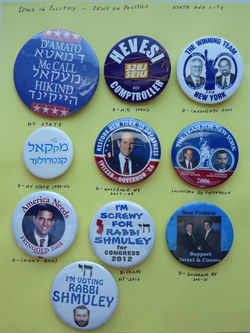 Jews On & In Local Politics |  Campaign Buttons |  Campaign Buttons. |
 2000.Democrat |  2000.Democrat |  Hopefuls.2000 Democrat |
 P1080026_edited |  Joe LiebermanLieberman was the first Jewish candidate of a major party ticket when he ran for V. president with Al Gore in 2000. In 2004 he ran for president, but dropped out 3 weeks later, having lost 5 primaries. His Orthodox practice was a notable feature of this candidacy. |  Hopefuls.2004.Democrat |
 2004.Republican | 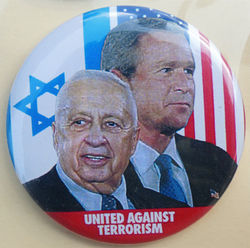 George W. BushGeorge W. Bush was the 43rd U.S. president from 2001 - 2009. He supported Israeli Prime Minister Ariel Sharon's plan to disengage from Gaza in 2005. The 2 men are pictured here, alluding to their positive relationship. |  Obama.2008 |
 Obama.2008 |  Barack ObamaObama was president from 2009 - 2017. A popular image of numerous candidates shows them visiting the Western Wall in Jerusalem. This would indicate how much the candidate cared for Israel and for the American Jewish voter. |  Hopefuls.2008 Democrat |
 Hopefuls.2008 Republican |  Hopefuls.2008 Republican | 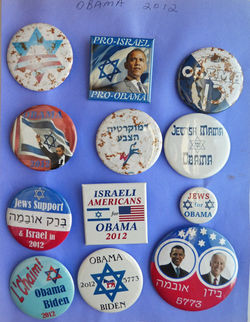 Obama.2012 |
 Obama 2012 |  Romney.2012 |  Hopefuls.2012 |
 Trump.2016.Republican |  Donald TrumpTrump was the 45th president, from 2017 - 2021. He was supported for many reasons, but an interesting factor was his daughter Ivanka. She converted to Orthodox Judaism and married Jared Kushner in 2009. |  Hopefuls.2016.Republican |
 Hopefuls.2016.Democrat |  Hopefuls.2016.Democrat |  Bernie SandersBernard Sanders was a Democratic presidential candidate in 2016 and 2020. He is notable for his left-wing social democratic and progressive policies. Sanders became Bar Mitzvah in 1954, and volunteered on a kibbutz in 1963. He describes his Jewishness as ethnic, not religious. |
 Trump.2020.Republican |  Biden.2020.Democrat |  Joe BidenJoe Biden has been the 46th president since 2021, after having been V. president under Obama (2009-2017). The many Jewish /Hebrew pins attest to his support. This pin is remarkable. It shows the initials of Biden - a Hebrew Bet - and (V. president) Harris - a Hebrew Hay - with apostrophes in between. This is fitting, but it is also an exact representation of a commonly abbreviated Jewish blessing: 'Baruch Hashem', meaning 'Praise the Lord' ! |
 Hopefuls.2020 | 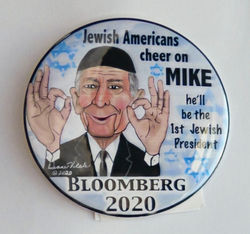 Mike BloombergNew York Mayor Mike Bloomberg ran for president in 2020. Despite heavy campaign spending, he didn't get much traction and dropped out after 4 months. This button emphasizes his Jewishness. |  Bush & War in IraqThese buttons are not 'Jewish'. They reflect the strong feelings, both pro- and con-, for the war in Iraq. It was in the wake if 9/11 and many including Jews had definite opinions. |
 Jewish IdentityTo counteract assimilation, various organizations raised awareness of Jewish identity. |  Jewish is BeautifulAfter the "Black is Beautiful' slogan caught on, many other ethnic groups and nationalities imitated it, as did this one. |  Jews for Moses.'Jews for Jesus' incorporated in 1973. It is a Christian messianic movement that aims to convert Jews. They have succeeded in convincing some Jews that belief in Jesus can be incorporated into their Jewishness. This button was an attempt to counteract those activities. |
 Jewish Schools |  Jewish Schools.Flatbush |  Y.U. High Schools |
 Jewish College Students |  Jewish Education"The study of Torah is weighed against all the Commandments" is a Talmudic statement that emphasizes study of Jewish sources. It explains why the first communal undertaking in a new Jewish community is traditionally the school. |  Jewish Youth, Camps, Hotels |
 NCSYThe full name of this Orthodox youth organization is National Conference of Synagogue Youth. it was formalized in1959 and provided after-school, weekend, and summer programs for public school and private school Jewish youth. There are hundreds of chapters, many with their own name and a button to proclaim it. |  NCSYOne of their generic buttons. |  NCSY Chapters |
 Sabbath ObservancePromoting observance of the Jewish day of rest, from sundown Friday until dark on Saturday. |  Sabbath CandlesThe Sabbath is inaugurated with lighting candles in the home, usually by the mother of the family and often joined by growing daughters. At least two, some families light one for each family member. Here they are shown near the 2 Challah loaves of the evening meal. |  Holidays |
 Charity and Fundraising |  Chai Lifeline.Chai ('life') Lifeline is an organization that supports seriously ill children and their families. Camp Simcha is their summer program. There is 1-on-1 counselor supervision, an expert medical staff, and a wide variety of activities. Attendance is completely free to families. |  Careful Speech |
 LHMFGAbbreviation for the saying: 'Lashon Hara Means Fire & Gehenom'. 'Lashon Hara' means careless and defamatory speech - something specifically forbidden in Jewish law. This was an effort to encourage teens to watch their mouths. It is a tongue- in-cheek take-off on Lucky Strike's slogan 'Lucky Strike Means Fine Tobacco' from the 1960s. |  Religious IssuesReligious issues of the day included: Modest dress, Converting to Judaism according to traditional guidelines, Gender separation during prayer and dance, etc. |  Dare to Be DifferentThis button was addressing Jews who attend public school. In the 1960s, many Jews were uncomfortable wearing a Kippah in non-Jewish public environments. How much more-so for young Jews in school. So 'Dare to Be Different' and proudly wear your kippah. Likely an NCSY issue. Things have changed somewhat since. |
 Promoting Religious ObservanceTefillin, Torah, Kosher, Mezuzah, Tzedakah, Study... |  Eating KosherPromoting Kosher eating and some well-known kosher food brands. |  Prayer and Torah StudyPromoting Prayer and Torah Study. |
 Synagogue AttendanceLikely inspired by the 1969 movie 'Support Your Local Sheriff'. 'Minyan' is a quorum of 10 or more that gather for daily formal prayer services. Praying with a quorum is considered more desirable than praying alone. |  Promoting Religious Observance'Uncle Moishy' is a Jewish entertainer who addresses children through song and performance. His themes are related to religious observance. He is affiliated with the Chabad-Lubavitch movement. |  Uncle MoishyMore Uncle Moishy themes. |
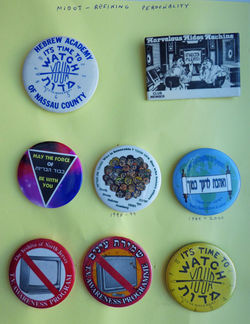 Refining Personality'Midot' are personality and behavior characteristics. Improving them is a lifelong pursuit. They are the hallmark of a refined, careful, considerate person. A classic example is 'Love (treat) Your Fellow As Yourself'. Promoted especially in schools. |  Soviet Jewry MovementThe movement to 'Free Soviet Jewry' developed in the mid-1960s. It was supported by establishment agencies, augmented by grass-roots organizations such as SSSJ - Student Struggle for "Soviet Jewry. |  Soviet Jewry MovementThe main slogan of the movement was 'Let My People Go', borrowed from the Biblical Exodus story. Marches and demonstrations became frequent. |
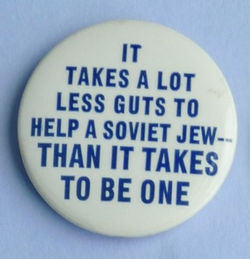 RefuseniksUnder Khrushchev, a campaign against religion targeted Jews, closing synagogues, imprisoning leaders, forbidding emigration. Applicants who were denied emigration were labeled 'Refuseniks' and harassed. Following Israel's 1967 victory USSR severed all ties with Israel. Zionism was a crime. Under pressure, things changed in the 70s and emigration began. |  Soviet Jewry Movement |  Soviet Jewry Movement |
 Soviet Jewry Movement"Russia is Not Healthy for Jews and Other Living Things'. This slogan was inspired by a contemporary anti-Viet Nam war slogan: 'War is not healthy for children and other living things'. |  Soviet Jewry Movement.PepsiWhen Pepsi Cola Corporation signed a trade agreement with the USSR in 1972, a boycott was declared against their products. One button reads 'Pepsi Kills' which is ironic when remembering a 1960s Pepsi slogan "Come Alive, Your in the Pepsi Generation'. |  Russian Jewry.PepsiWhen Pepsi Cola Corporation signed a trade agreement with the USSR in 1972, a boycott was declared against their products. One button reads 'Pepsi Kills' which is ironic when remembering a 1960s Pepsi slogan "Come Alive, Your in the Pepsi Generation'. |
 Prisoners of ZionJews jailed for wanting to emigrate became known as 'Prisoners of Zion'. Some became famous as the face of the whole issue. Sylva Zalmanson, Natan Scharansky, Yosef Mendelsohn, are examples. |  Soviet Jewry'Berlin 1936, Moscow 1980, Olympics of Oppression'. |  Syrian JewryThe venerable Jewish community came under oppression and restrictions after the 1948 war. It worsened after 1967 war: confiscation, house arrest, unemployment, and even pogroms. Many escaped into Turkey and from there to Israel or Europe. In the 70s, some emigration was permitted on condition that it not be to Israel. From 30,000 in the 1950s, there are only about 40 left today. |
 Ethiopian JewryThe origins of the Ethiopian Jewish community are vague. They achieved official recognition as Jews by Israel in the 1970s. The Ethiopian government's adoption of Communism led to Jewish persecution. Civil war and famine threatened their existence. Israel staged a series of airlift evacuations, culminating in Operation Solomon in 1991. Some made a dangerous trek to Addis Ababa to reach the planes. Between 1990 and 1999, over 39,000 Ethiopian Jews entered Israel. |  Early Communal ButtonsJews made ample uses of buttons to identify and promote their organizations. |  'Hapoel' in PalestineHapoel soccer club was founded in 1926. 'Hapoel' means 'the worker' and was affiliated with the Labor Movement in Palestine. In those days a 'Palestinian' was a Jew living in the Holy Land, while Arabs identified with the larger Arab population in the region. |
 Activism Among JewsSocial minded Jews supported activist movements of the day. Feminism, abortion, anti-war, civil rights, anti-Semitism, are represented. |  Women's LiberationWomen's Lib organizations began forming in the 1960s. Jewish women were in the forefront of the movement. The famous leader Betty Friedan is an example. The movement built on earlier activism for suffrage, civil rights, and anti-war causes. |  Anti-Vietnam WarAnother example of Jewish activism as there were many who supported the anti-war movement during the Viet-Nam era. |
 HolocaustHolocaust themes include 'Zechor' (Remember), Never Again, 'I Only followed Orders' (Eichman's defense at his trial in Israel), Remembrances, Museums, and movies. |  Never AgainIn the context of the Holocaust, the phrase 'Never Again' was first used by survivors in the Buchenwald camp in 1945. Here we see it with a bloody Star of David, and also printed over the names of Concentration Camps and other Jewish catastrophes. The term has since been co-opted for wider causes and even appears in popular culture. |  Holocaust ThemesTerms associated with the Nazis and the Holocaust have continued to be used as expressions of total evil. Once they are thrown around for every disliked leader, they lose serious meaning and cheapen the significance of what happened, and the memory of the victims. |
 Hitler in the white HouseThis extreme language, and misuse of terms, lowers the level of political discourse and cheapens the meaning of history. |  CelebrationsWeddings, Bat-Mitzvahs, anniversaries, and even mourning are all marked by buttons. |  MiscellaneousButtons are used for humor, advertising, and even silliness. |
 Free PollardJonathan Pollard was convicted of stealing U.S. secrets and selling them to Israel. He was sentenced to life in prison. Actually he was giving Israel information that the U.S. was supposed to share but didn't. Pollard was trying to protect Israelis & Americans. The U.S. violated his plea deal and Pollard served 30 years before his release. |  Maimon Family Buttons |  Early Buttons For Israel |
 State of IsraelWith the impending end of the Mandate and departure of British governance, the U.N. voted (November 29, 1947) for partition of the Holy Land and the existence of a Jewish state. It could no longer include the Transjordan area, which the British had allotted to Arab control back in 1920, not long after the Balfour Declaration had declared Palestine to be a Jewish homeland. But some Jews remembered the original promise.... |  Jewish National FundThe Jewish National Fund (JNF) was established in 1901 to purchase land in Ottoman Syria/Palestine for the purpose of Jewish settlement. Every inch was paid for by funds supplied by Jews around the world. After 1948 it became known as the 'Keren Kayemet Leyisrael' (KKL). The focus has been on land reclamation, afforestation, and water conservation. |  Israel Independence DayIsrael Independence Day is officially May 14th in the secular calendar but is observed on the corresponding Hebrew date (in 1948) of 5th of Iyyar. Parades are held on or near the date when these buttons are distributed. |
 Israel's WarsIsrael's 'formal' wars in 1948, 1956, 1967, 1973 and later conflicts have generated buttons. Themes focus on the IDF, survival, peace, successful defense, and casualties. |  1967 French Arms EmbargoThe 1967 Arab-Israeli war presented the frightful image of 3 neighboring Arab nations attacking Israel. 50 jets, that had been ordered from France and paid for, were waiting for delivery. France, ever mindful of its relations with the Arab world, withheld delivery as part of an arms embargo. Thus 'Long Live France; Down With (French president ) Pompidou'. |  War AftermathPost-war issues included POWs and 'occupied territory', which included the 'West Bank', the Golan Heights, and Gaza. All had been sources of hostility before Israel took control of them. |
 Free Gilad ShalitShalit was captured in 2006 by a cross-border Palestinian squad that entered Israel thru a tunnel. His tank partners were killed. He was held in isolation for 1,934 days before he was exchanged for 1,027 prisoners, who were responsible for killing 569 Israelis. It was a very controversial issue. |  Peace EffortsEveryone claims to want peace but actual progress is illusive. P.M. Yitzchak Rabin was assassinated for his efforts. P.M. Ariel Sharon unilaterally evacuated the Gaza Strip, leaving behind homes, farms, even synagogues. He was rewarded with constant terror. A 'Two State Solution' does not hold much promise. |  Victims of TerrorNearly 4000 non-combat civilians have been murdered by Arab terrorists since the founding of the State. Four times that number have been wounded. There is no end in sight. |
 Victims of TerrorThe Israel emergency Solidarity Fund issued this set of buttons picturing some of the over 200 victims in 2001 alone. |  Victim Shalhevet PassOn 26 March 2001, Shalhevet was shot in her stroller while accompanied by her parents in Hebron's Avraham Avinu neighborhood, where the family lived. A sniper from an opposite hill successfully murdered her and she became a 10 month old face of civilian victims of terror. Avraham, age 4, was murdered a few months later. |  Support for IsraelVarious student and activist groups conduct campaigns to support Israel. |
 Support for IsraelBuying Israel bonds, purchasing Israeli merchandise, and supporting Israeli institutions all contribute to the cause. |  Meir Kahane.KachMeir Kahane was a religious & Israeli nationalist activist with a rabbinical and a law degree. He founded the JDL (Jewish Defense League) in New York to defend Jews against anti-Semitic attacks, and the 'Kach' political party in Israel. |  JDLKahane founded the JDL (Jewish Defense League) in New York in 1968 to defend Jews, especially the poor and elderly, against anti-Semitic attacks. He believed in push-back to hostility. His slogans were 'Never Again' and 'Every Jew a 22'. He was assassinated in New York City by an Egyptian in 1990. |
 Kach PartyKahane moved to Israel in 1971. Influenced by the Beitar philosophy, he founded the Kach party. He was elected to Knesset in 1984. His party had an assertive and aggressive stance toward Arab hostility and attracted a large following. It was banned as racist in 1988. |  JerusalemJerusalem has an historical and emotional place in Jewish consciousness. It is also a political hot potato. |  Jerusalem.Capitol of IsraelEast (Old City) Jerusalem remained in Arab hands after the 1948 war. (The U.N. plan was for it to be International.) In 1967, it came under control of Israel, who was determined that it remain undivided. Naturally Arabs claim it as theirs. Whether foreign embassies should be located there is the subject of this pin. |
 El Al_AirlineEl Al ('Heavenward') is the national airline of Israel. |  Miscellaneous IsraelProducts, kibbutz, elections, holy places ..... |  AliyahAliyah ('ascent') means emigrating to Israel. It lies north of many countries but more significantly, Aliyah represents a spiritual ascent. Traditionally, it is the ultimate aspiration of every Jew. |
 P1080031_edited |  Buttons_edited |